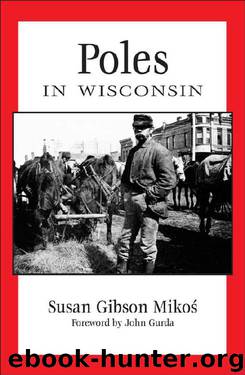Poles in Wisconsin (People of Wisconsin) by Susan Gibson Mikos

Author:Susan Gibson Mikos [Mikos, Susan Gibson]
Language: eng
Format: epub
Publisher: Wisconsin Historical Society Press
Published: 2013-02-22T06:00:00+00:00
CREATING THE URBAN VILLAGE
Milwaukee’s Polish neighborhoods, on both the South and the East Side, shared distinctive characteristics, partly derived from their Old World heritage. Most Polish peasants were accustomed to living in close-knit villages, where houses clustered tightly together around an open space or along a single street. Behind each wooden cottage was a yard with a barn and other outbuildings. The yard served as a work area and as home to the family poultry. In the garden next to, in front of, or behind the house, the family cultivated a combination of vegetables, herbs, and flowers.
When they moved to American cities, the majority of Polish immigrants eschewed tenement buildings in favor of small, detached houses. Contemporary social reformers complained that the yards of Polish immigrants exhibited conditions more befitting a village farmyard than a city lot — muddy, strewn with refuse, and often sporting barns or chicken coops. Vegetable gardens were squeezed between the front and rear houses. Chickens, ducks, and geese were common; some householders even kept pigs and cows.
Polish immigrants brought with them an intense desire to own property. Owing their livelihoods to the soil, Polish peasants valued land ownership above almost everything, except perhaps their Catholic faith. In Milwaukee, Poles rapidly achieved an extraordinarily high rate of home ownership, especially considering their modest incomes. Typically, a family began by building a small cottage on a narrow house lot, and then, as soon as finances permitted, they expanded it by the least expensive means. A 1911 study by the British Board of Trade described a typical building sequence and the crowding that resulted:
In the South Side district, where a large class of the poorer section of the Poles live, the custom is to erect first a four-roomed frame dwelling. When this has been paid for, it is raised on posts to allow a semi-basement dwelling to be constructed underneath, the lower portion being banked round with clay to afford protection against the snow in winter. This basement or the upstairs flat is then let by the owner, who, as soon as his funds permit, substitutes brick walls for the timber of the basement, but the ambition of a Polish house-owner is not crowned until he is able to have cement walks and iron railings in front of his house. In the above district a very large number of these semibasements of wood can be seen, and although the outer aspect of the dwellings is not unpleasing, they are in general undeniably insanitary, being damp, as the floor of the basement rests on the ground. Such houses, which when completed, contain eight rooms, are frequently occupied by four or five families as well as boarders, and as Polish families are generally large this overcrowding is a serious evil.
The distinctive type of dwelling that resulted from jacking the house up and building a high basement beneath it came to be known as a “Polish flat,” since it was common in Polish neighborhoods. Other homeowners expanded their houses by adding onto the back or raising the roof, although these methods could be more costly.
Download
This site does not store any files on its server. We only index and link to content provided by other sites. Please contact the content providers to delete copyright contents if any and email us, we'll remove relevant links or contents immediately.
| African-American Studies | Asian American Studies |
| Disabled | Ethnic Studies |
| Hispanic American Studies | LGBT |
| Minority Studies | Native American Studies |
Cecilia; Or, Memoirs of an Heiress — Volume 1 by Fanny Burney(32053)
Cecilia; Or, Memoirs of an Heiress — Volume 3 by Fanny Burney(31449)
Cecilia; Or, Memoirs of an Heiress — Volume 2 by Fanny Burney(31401)
The Great Music City by Andrea Baker(30778)
We're Going to Need More Wine by Gabrielle Union(18625)
All the Missing Girls by Megan Miranda(14702)
Pimp by Iceberg Slim(13770)
Bombshells: Glamour Girls of a Lifetime by Sullivan Steve(13680)
Fifty Shades Freed by E L James(12907)
Talking to Strangers by Malcolm Gladwell(12863)
Norse Mythology by Gaiman Neil(12818)
For the Love of Europe by Rick Steves(11429)
Crazy Rich Asians by Kevin Kwan(8883)
Mindhunter: Inside the FBI's Elite Serial Crime Unit by John E. Douglas & Mark Olshaker(8695)
The Lost Art of Listening by Michael P. Nichols(7154)
Enlightenment Now: The Case for Reason, Science, Humanism, and Progress by Steven Pinker(6868)
The Four Agreements by Don Miguel Ruiz(6310)
Bad Blood by John Carreyrou(6271)
Weapons of Math Destruction by Cathy O'Neil(5823)
